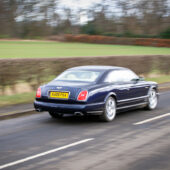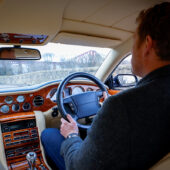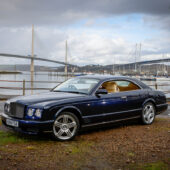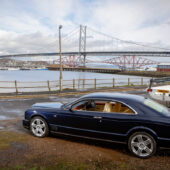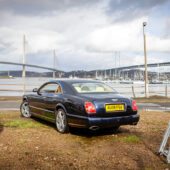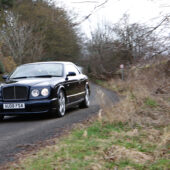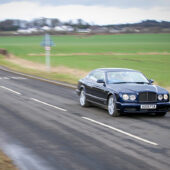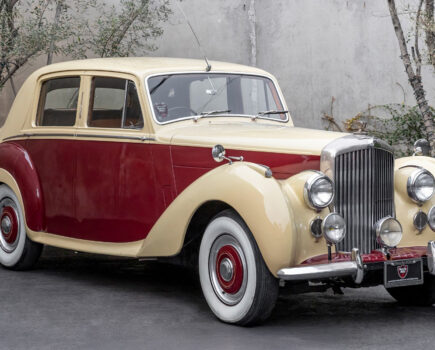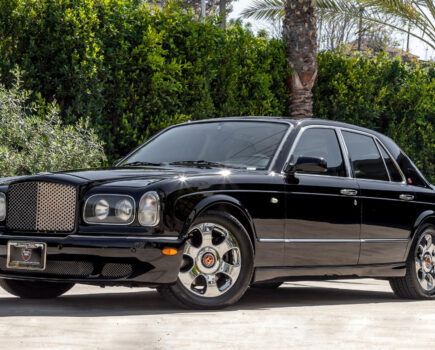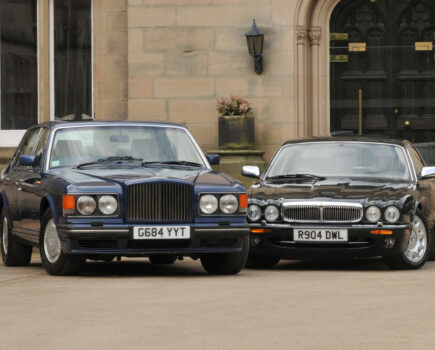Most will remember the four-door Bentley Brooklands saloon of the 1990s rather than this low-production coupé – which now seems one of the best-kept secrets of all high-performance luxury cars
Words: Nigel Boothman Images: Lewis Houghton
It’s quite a place to be. There’s more room in here than in the superficially similar but unrelated Continental R, with heaps of seat adjustment both in height and reach so anyone can get comfortable. The front seats are splendid, a fine mix of sumptuousness and support, being slightly more bolstered than those in the car’s Arnage saloon relatives. There is a button on the dash that drops all the side windows with one touch; hard to resist once you’ve discovered it.
Yet despite the size, the impression for the driver is of looking out through a somewhat ‘pillarbox’ view. It has a low roofline, a steeply raked windscreen and a rising hump over the main instruments in the dash. With the seat adjusted for a comfortable view out, I can fold the sun visor down and obscure the entirety of the view forward. Some of the quirky old ergonomics have survived well into the VW-controlled company, and as we’ll discover, this feeds into a rather Crewe-era character for this 2008 car.
The steering always has a bit of weight – a one-finger waft-mobile this is not. The ride is interesting. Even without the SPORT button pressed, which stiffens things considerably, it feels as though it’s set up to allow the car to be driven terribly quickly and still feel secure. At low speed, you can tell a lot of effort has gone into controlling this huge mass of around 2700kg, with excellent insulation from the smaller bumps and ripples. But larger holes are not something you float over like you might in a four-door luxury liner; whatever the clever damping can do, the spring rates are too high for that.
It’s beautifully trimmed, even by Bentley standards. There’s a different feel from the W12-engined cars with their shared Audi/VW architecture, even down to an errant squeak from behind the steering wheel that sounds like leather rubbing on polished timber. Once again, old-school Bentley, not 21st century. There are eyeball vents and organ-stop plungers for the ventilation, familiar to any Arnage owner and indeed owners of previous generations. There are two hinged covers for parts of the dash, obscuring vulgarities like the radio fascia and ashtray, while elsewhere there are business-like black buttons with a rather alarming option: ‘ESP OFF’. Feeling brave?
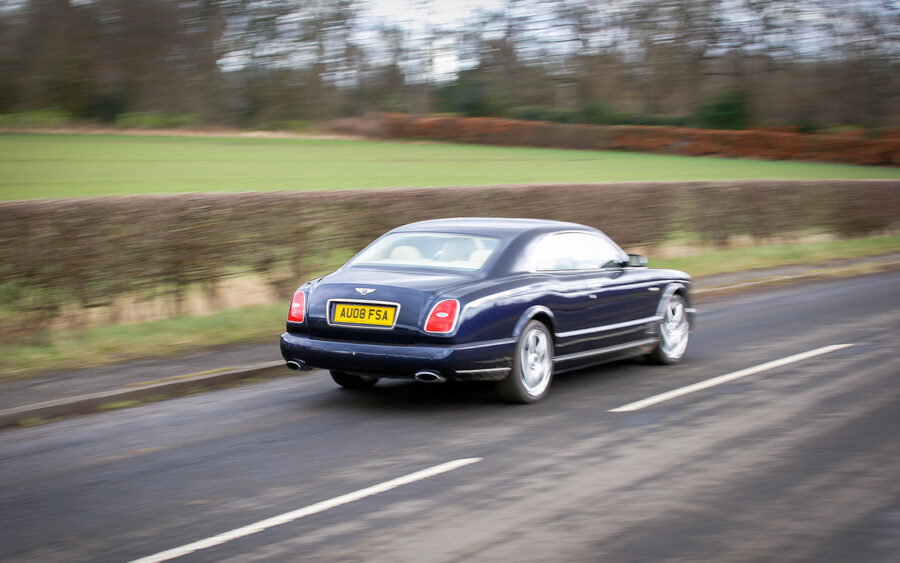
Before we venture out of Edinburgh and find a route along faster roads to the Forth bridges, it’s worth placing this car in Bentley chronology. The Brooklands made its debut at the Geneva show in 2006, where Bentley’s intentions were clear: this would be a more expensive, more exclusive option than either the Arnage or Continental GT, with lifetime production limited to 550 units. It was a natural step after the announcement of the new Azure (originally called the Arnage Drophead Coupé) in April 2005, a two-door, four-seater drophead on the same wheelbase as the Arnage saloon. It replaced the previous Azure, based of course on the SZ-generation Continental R. So did the new Brooklands take the place of the Continental R itself…or had the Continental GT already done that?
It’s an interesting question. The Continental GT was proving an enormous success in all ways but one: it was selling in such numbers that exclusivity was draining away. It was also noticeably different in feel, in style and in mechanical origin to the last of the Crewe-era cars, the Arnage. But it’s immensely potent W12 engine gave Bentley a problem – how do you sell a limited-production halo model like the Brooklands with fewer cylinders and less power than the standard Conti GT? By 2007, that W12 was making 551bhp at peak, or just over 600bhp in the GT Speed.
First, you go for exclusivity – that limit on production – and second, you find another way to make the driving experience a rare thrill. Bentley’s engineers knew there was yet more potential in the ever-developed L-series V8 and concentrated on torque output rather than power. For the Brooklands, they started with the 500bhp Arnage T engine and worked on increased flow through the inlet tract and exhaust, also playing with the turbos, the camshaft profile and the engine management to increase power to 530bhp, but mainly to release an amazing 774lb ft (1050Nm) of torque at 3250rpm, a world record for any production petrol engine at the time. So what does it feel like?
Setting off smoothly is a little tricky. A faint touch of the throttle produces a whispering, gentle getaway, but as you add what feels just a millimetre or two more, the immense flood of torque spills over and pushes the car forward. This problem becomes a benefit if you drive in a more spirited manner, but that brings its own challenges, not least in hanging on to your licence. It is startlingly fast, responding with near-violence at any point of the rev range, at any speed. The automatic transmission is never flustered but sometimes you wonder whether it’s required at all. The venerable L-series V8 is very low-revving by modern standards (4500rpm redline) but even so, you reach that 3,250rpm torque peak quite easily, especially if you use the Tiptronic feature and select the gears yourself. In fact, the torque curve would reveal planet-spinning figures well below that, so even when the engine is barely off idle there is this colossal force waiting to hurl you along. And what if you really dig in, and push that large accelerator pedal right down into the carpet?

It’s like a piano falling down a lift shaft. That’s a silly metaphor, but perhaps it captures something of the way such a heavy object can accelerate in a plunging, exponential way, until you wonder if it would ever stop. The numbers suggest it will eventually settle to a top speed of something over 180mph, but this doesn’t really tell the tale. Bentley’s own figures timed the car leaping from 30mph to 50mph in 1.6 seconds, and on to 70mph in another 2.4 seconds. The 0-60mph time is 5 seconds dead; I bet it’s not much more from 60mph to 120mph. All of this drama occurs with no more than a subdued boom from under the bonnet and a well-muffled whoosh from the exhaust, and then suddenly you have to ease off and it all settles back to normal. It left the photographer and I looking at each other, eyebrows raised, as if to ask, ‘did that really just happen?’
It did. It’s a strange experience, which because of the lack of any wheelspin or nose-in-the-air dragster behaviour, doesn’t feel entirely car-like. A fighter jet on a steam catapult, launched off an aircraft carrier? Yes, but look at your surroundings – if your objective is luxurious comfort at all times, with immense performance on a whim, it’s hard to imagine a more capable car. You would expect some compromise in cornering behaviour, but it just goes where it needs to go and has grip levels you would be insane to test on any public road. The brake pedal is firm and the brake discs are the size of dustbin lids; like the tyres, they seem to be a long way from their performance limits even in press-on driving.
There are a few tiny disappointments. The analogue radio-CD isn’t easy to use, the seat heaters aren’t very potent and the climate control takes its time to assert itself. There is a massage function in the seats which starts working on me unexpectedly, and the controls are nowhere I can spot while on the move. The reaction to the Brooklands from passers-by is interesting. Sometimes there’s a slight frown, not necessarily because they disapprove, but because they’re not sure what it is. And if they’re keen enough on cars to clock the flying B, they seem unsure whether to adore it as an impressive classic or resent it as an opulent modern device. One passer-by at the marina where we stopped for a few photos offered us a ‘nice car, mate’. We could only agree.
It is very much a 21st-century car built in the manner of the classic Bentley. It looks and feels a good bit older than it is, except in terms of performance, but that’s a compliment rather than a criticism. There is a modern car underneath trying to get out, but a modern car that’s been retro-fitted with a few SZ-generation thumps and wobbles over rough city streets and non-intuitive minor controls. In my seating position, I can’t see the switches for the steering wheel position, boot release, fuel flap release or headlamps.
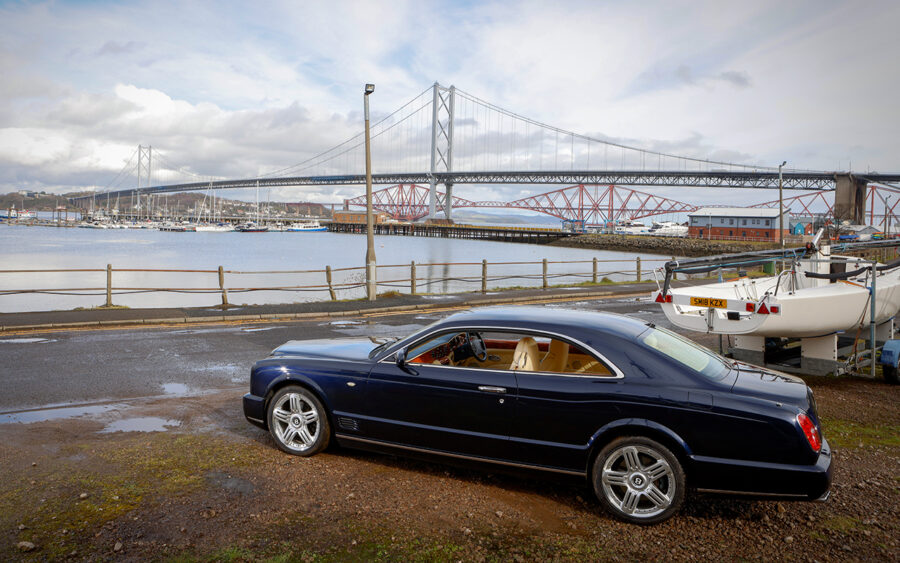
It would take a little getting to know, I think, and would be all the better for that. The Brooklands would start to shrink around you and you’d be less nervous of being unable to see the nearside front quarter or either of the rear corners. The boot is rather on the mean side for such a big car – one large suitcase and one small one, perhaps – but for the chance to spend a week crossing Europe in such a machine you’d pack carefully, wouldn’t you?
If you went into the showroom in 2008 and tried one of these and a Continental GT, you’d notice a difference in scale and proportion, even though the diamond-stitched interiors, the quad headlamps and some of the dash furniture were signs of a close relationship. Get out on the road and the difference would be amplified significantly. Old-school Bentley versus new Bentley, the former priced at £236,455 before options, at launch – almost exactly twice what a Conti GT cost at that time. Much more hand-built than a Continental GT, much more exclusive, much more spacious inside and by my reckoning, more comfortable too.
This one has only covered 20,000 miles and has been looked after like a favourite daughter, so it’s as close as we could get to experiencing a new Brooklands in 2008, when the first deliveries began. It’s been something of a revelation; one that showed how conscious Bentley still was of its heritage and its traditional customer base. Why? Because the car it sets out to remind you of, both visually and in the imperious way it covers the miles, is the Continental R.
That car saved Bentley in the 1990s, when the SZ saloons were barely breaking even, but the Brooklands never needed to play that role. Indeed, even with the huge list price it’s doubtful the company made much money from this limited production run, thanks to the labour-intensive build – the roof and rear quarter-panel had to be hand-welded, for example. So it exists only for two reasons: partly because of the arrival of the Rolls-Royce Phantom Coupé shortly after this car, which couldn’t really go unopposed, but mainly because Bentley wanted to reassert some credibility as a maker of the very finest, most luxurious, most impressive performance cars in the world.
Job done, I’d say. By 2011 the last one had sold and production ceased. They now appear on the market for about half what they cost new, which is vastly less than a current Continental GT. Why compare the Brooklands with a new GT? Because it wasn’t directly replaced. The L-series V8 lived on in the Mulsanne saloon until 2020, but despite a flirtation with a convertible concept for that car back in 2014, no two-door coupé version ever emerged. So what the Brooklands represents is the last range-topping Bentley coupé with the amazing old V8. That sounds a decent investment to us.
It leaves just one point to consider – with that status, such performance and such heritage, why isn’t the Brooklands better known? There’s one obvious answer: this car is the heir to a long tradition of fast, graceful, expensive two-door Bentleys with a very famous name, but that name had been co-opted by Bentley’s new management for use on the entry-level model. Yes – the Brooklands is really the last true Bentley Continental.



